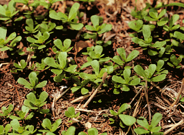I love eating weeds. It is free, super healthy and effortless to grow them. Buying them from a fancy schmancy specialty market is usually very pricey. Early this year, I pulled out an evergreen shrub that was lining my driveway, leaving behind a brown dirt strip of decomposing mulch. I’m sure the neighbors were expecting me to replace it with another landscaping plant, but I didn’t. I left it bare with no plan. It weeded over. I paid no attention to the weeds that came in because they were not anything I recognized from my foraging lessons. One day in June, our foraging class came to my home and my guide informed me that it was Purslane that took up residence in that bare brown sun scorched earth and it is a marvelous food. I hit the jackpot. Blessed by the bounty of Mother Nature, chosen by Providence. Of all the things that could have decided to grow there, I got Purslane!
That twiggy thing that looks like a Jade plant growing out of the cracks of sidewalks and on the hot and dusty god forsaken patches of earth is Purslane. Your landscaper will tell you it is a pest and offer to help you remove it with chemicals. Banish the thought. It is one of the best plant foods you could possibly eat.
Purslane contains more omega-3 fatty acids (α-linolenic acid) than any other vegetable and even some fish oils. Has a ton of vitamin A, C and some B-complex vitamins (riboflavin, niacin, pyridoxine and carotenoids). It is also high in iron and other minerals (magnesium, calcium, potassium and manganese).
The way I like to eat Purslane is to pluck off the top leaves (you can eat the stems, but I leave em in the garden). I rinse the leaves in a bucket and, because they have flowered and gone to seed by August, I save the rinse water with seeds at the bottom (they look like poppy seeds) and throw out the water on my lawn so I can grow more Purslane. I like to imagine landscapers cringing at that image. Then I dry the leaves and toss em with lemon juice, oil and salt and pepper. You can eat them straight raw and I recommend you try that too so you know what they taste like, b/c they have this pleasant lemony flavor. You can cook it too, pretty much any way you like, although I’ve been avoiding that b/c fatty acids tend to lose their potency when heated.
There are a slew of recipes all over the web and on Epicurious.
Purslane flowers from May to November and spreads by seeds, which germinate in the spring, or by stem fragments. I have a nice long Purslane season ahead of me. Thank you Purslane for choosing to inhabit my yard. I’m so glad I made the room for you. Pshaw evergreen, don’t miss you much, good riddance, nice tradeoff.

Posted on August 11, 2011 by Sustainable Sachi
0